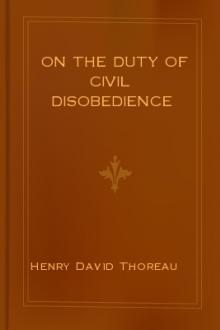Essays Henry David Thoreau (little bear else holmelund minarik .txt) 📖

- Author: Henry David Thoreau
Book online «Essays Henry David Thoreau (little bear else holmelund minarik .txt) 📖». Author Henry David Thoreau
As we travel northwest up the country, sugar-maples, beeches, birches, hemlocks, spruce, butternuts, and ash trees prevail more and more. To the rapid traveller the number of elms in a town is the measure of its civility. One man in the cars has a bottle full of some liquor. The whole company smile whenever it is exhibited. I find no difficulty in containing myself. The Westmoreland country looked attractive. I heard a passenger giving the very obvious derivation of this name, West-more-land, as if it were purely American, and he had made a discovery; but I thought of “my cousin Westmoreland” in England. Everyone will remember the approach to Bellows Falls, under a high cliff which rises from the Connecticut. I was disappointed in the size of the river here; it appeared shrunk to a mere mountain stream. The water was evidently very low. The rivers which we had crossed this forenoon possessed more of the character of mountain streams than those in the vicinity of Concord, and I was surprised to see everywhere traces of recent freshets, which had carried away bridges and injured the railroad, though I had heard nothing of it. In Ludlow, Mount Holly, and beyond, there is interesting mountain scenery, not rugged and stupendous, but such as you could easily ramble over—long narrow mountain vales through which to see the horizon. You are in the midst of the Green Mountains. A few more elevated blue peaks are seen from the neighborhood of Mount Holly, perhaps Killington Peak is one. Sometimes, as on the Western Railroad, you are whirled over mountainous embankments, from which the scared horses in the valleys appear diminished to hounds. All the hills blush; I think that autumn must be the best season to journey over even the Green Mountains. You frequently exclaim to yourself, what red maples! The sugar-maple is not so red. You see some of the latter with rosy spots or cheeks only, blushing on one side like fruit, while all the rest of the tree is green, proving either some partiality in the light or frosts, or some prematurity in particular branches. Tall and slender ash-trees, whose foliage is turned to a dark mulberry color, are frequent. The butternut, which is a remarkably spreading tree, is turned completely yellow, thus proving its relation to the hickories. I was also struck by the bright yellow tints of the yellow-birch. The sugar-maple is remarkable for its clean ankle. The groves of these trees looked like vast forest sheds, their branches stopping short at a uniform height, four or five feet from the ground, like eaves, as if they had been trimmed by art, so that you could look under and through the whole grove with its leafy canopy, as under a tent whose curtain is raised.
As you approach Lake Champlain you begin to see the New York mountains. The first view of the Lake at Vergennes is impressive, but rather from association than from any peculiarity in the scenery. It lies there so small (not appearing in that proportion to the width of the State that it does on the map), but beautifully quiet, like a picture of the Lake of Lucerne on a music-box, where you trace the name of Lucerne among the foliage; far more ideal than ever it looked on the map. It does not say, “Here I am, Lake Champlain,” as the conductor might for it, but having studied the geography thirty years, you crossed over a hill one afternoon and beheld it. But it is only a glimpse that you get here. At Burlington you rush to a wharf and go on board a steamboat, two hundred and thirty-two miles from Boston. We left Concord at twenty minutes before eight in the morning, and were in Burlington about six at night, but too late to see the lake. We got our first fair view of the lake at dawn, just before reaching Plattsburg, and saw blue ranges of mountains on either hand, in New York and in Vermont, the former especially grand. A few white schooners, like gulls, were seen in the distance, for it is not waste and solitary like a lake in Tartary; but it was such a view as leaves not much to be said; indeed, I have postponed Lake Champlain to another day.
The oldest reference to these waters that I have yet seen is in the account of Cartier’s discovery and exploration of the St. Lawrence in 1535. Samuel Champlain actually discovered and paddled up the Lake in July, 1609, eleven years before the settlement of Plymouth, accompanying a war-party of the Canadian Indians against the Iroquois. He describes the islands in it as not inhabited, although they are pleasant—on account of the continual wars of the Indians, in consequence of which they withdraw from the rivers and lakes into the depths of the land, that they may not be surprised. “Continuing our course,” says he, “in this lake, on the western side, viewing the country, I saw on the eastern side very high mountains, where there was snow on the summit. I inquired of the savages if those places were inhabited. They replied that they were, and that they were Iroquois, and that in those places there were beautiful valleys and plains fertile in corn, such as I have eaten in this country, with an infinity of other fruits.” This is the earliest account of what is now Vermont.
The number of





Comments (0)